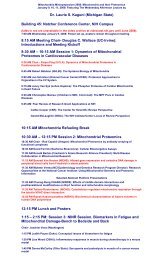RESEARCH ON THE FETUS - National Institutes of Health
RESEARCH ON THE FETUS - National Institutes of Health
RESEARCH ON THE FETUS - National Institutes of Health
You also want an ePaper? Increase the reach of your titles
YUMPU automatically turns print PDFs into web optimized ePapers that Google loves.
carotid and umbilical arteries <strong>of</strong> the aborted fetus and measuring fetal glucose<br />
levels in response to administration <strong>of</strong> growth hormone. Four fetuses from hysterotomy<br />
abortions at 16-20 weeks gestation were perfused via the umbilical vessels<br />
in a study in Scotland which demonstrated that the fetus could synthesize<br />
estriol independent <strong>of</strong> the placenta. A similar study by the same investigators<br />
involving six fetuses demonstrated that the 16-20 week fetus could synthesize<br />
testosterone from progesterone. To learn whether the human fetal brain could<br />
metabolize ketone bodies as an alternative to glucose, brain metabolism was isolated<br />
in eight human fetuses (12-17 weeks gestation) after hysterotomy abortion<br />
by perfusing the head separated from the rest <strong>of</strong> the body. This study, conducted<br />
in Finland, demonstrated that the human fetus, like previously studied animal<br />
fetuses, could modify metabolic processes to utilize ketone bodies.<br />
These studies <strong>of</strong> the nonviable fetus represent the total number reported in<br />
the world scientific literature, as well as could be ascertained from review <strong>of</strong><br />
the most comprehensive bibliographic search ever undertaken <strong>of</strong> research involving<br />
the human fetus. The total number <strong>of</strong> citations involving fetal research was well<br />
in excess <strong>of</strong> 3000; the reports <strong>of</strong> research on the nonviable fetus that were found<br />
numbered less than 20. Certainly some reports <strong>of</strong> such research may have been<br />
missed even by this thorough review, but it is safe to conclude that the amount<br />
<strong>of</strong> research conducted on the nonviable fetus has been extremely limited. Of the<br />
principal investigators conducting this type <strong>of</strong> research, three were from the<br />
United States; two <strong>of</strong> these investigators conducted their research abroad. The<br />
only research conducted in the United States on the nonviable fetus ex utero was<br />
the study involving attempts to develop an artificial life-support system. The<br />
literature survey disclosed no reports <strong>of</strong> research conducted in the United States<br />
on the nonviable fetus intended solely to obtain information on normal physiologic<br />
function.<br />
In summary, research involving the fetus includes a broad spectrum <strong>of</strong><br />
studies <strong>of</strong> the fetus both inside and outside the uterus. The research may be as<br />
innocuous as observation, or involve mild manipulation such as weighing or measuring,<br />
or more extensive manipulation such as altering the environment, administering<br />
a drug or agent, or noninvasive monitoring. Diagnostic studies may<br />
involve sampling amniotic fluid, urine, blood, or spinal fluid, or performing<br />
14











